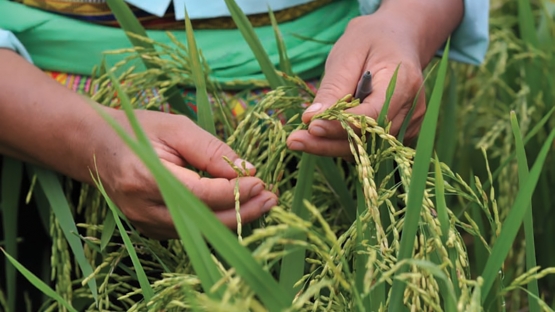The young Vietnamese farmer carrying his harvested rice wasn’t born when the Joint FAO/IAEA Division of Nuclear Techniques in Food and Agriculture began the work that has enabled him to have such reliable harvests. The work of the Joint Division in improving rice varieties for the fields of Vietnam dates back to the 1970s, when a post-war population boom was increasing food demand at the same time that changing climates had begun causing flooding and salt pollution which led to crop losses. These low production levels not only meant less food for the people of Vietnam. They also meant that the increased demand for export rice could not be met.
When the Joint FAO/IAEA Division of Nuclear Techniques in Food and Agriculture began working with Vietnamese scientists, its role was to pass on techniques of genetic mutation that could be used to improve local soybean and rice varieties. Although the overall goal was to meet increased food demand, the focus was not simply on developing varieties with higher yields. It also was necessary to insure the new varieties would be more resistant to pests and tolerant to environmental problems such as the salt inundation.
Mutation induction – applying nuclear and efficiency-enhancing biotechniques to speed up the natural mutation process of plants – has become an extremely successful component of modern agriculture. What could take tens of millions, if not hundreds of millions of years in nature is reduced to a decade or less through irradiating seeds with gamma rays to change their DNA structure. However the use of the radiation is just the first step of the process which depends on the input of local farmers as well as the nuclear scientists.
Once irradiated, the seeds are planted and, as they grow, scientists examine them to identify any mutations that have arisen due to the changed DNA. They select the ones that best serve their purposes for further study and development. Local farmers also participate in the selection process, bringing their knowledge of how the new mutations might actually respond in the field and how they might serve their needs.
In the early days of its relationship with Vietnam, the Joint Division equipped labs and trained scientists in genetic mutation techniques. By the 1990s, their new varieties had increased production and, seeking to expand its focus to meeting export demand, Vietnam established a partnership between the Joint Division and the Institute of Agricultural Science of South Vietnam (IAS). In this arrangement, the Joint Division provided irradiation services and advice to go along with it. IAS scientists brought their seeds to the Joint Division laboratories outside of Vienna to be irradiated and then took the irradiated seeds back to Vietnam for the planting and selection processes. Once the seeds grew, they invited local farmers to help in determining which traits were the best to pursue, making the selection while growing them under local conditions.



